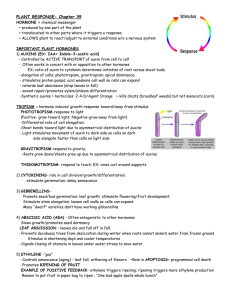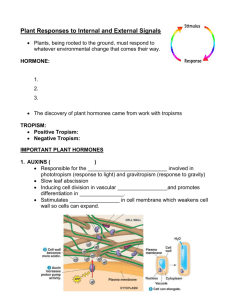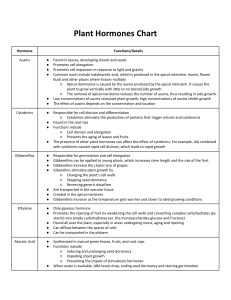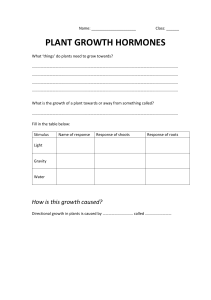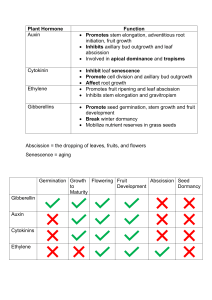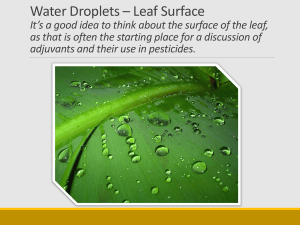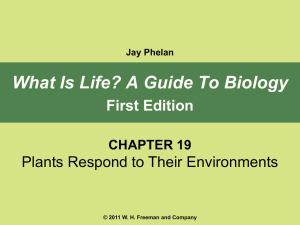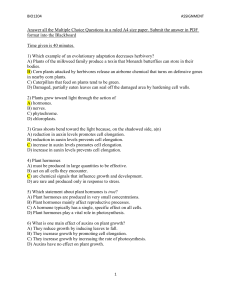Plant Responses: Herbivory, Tropisms, Hormones
advertisement
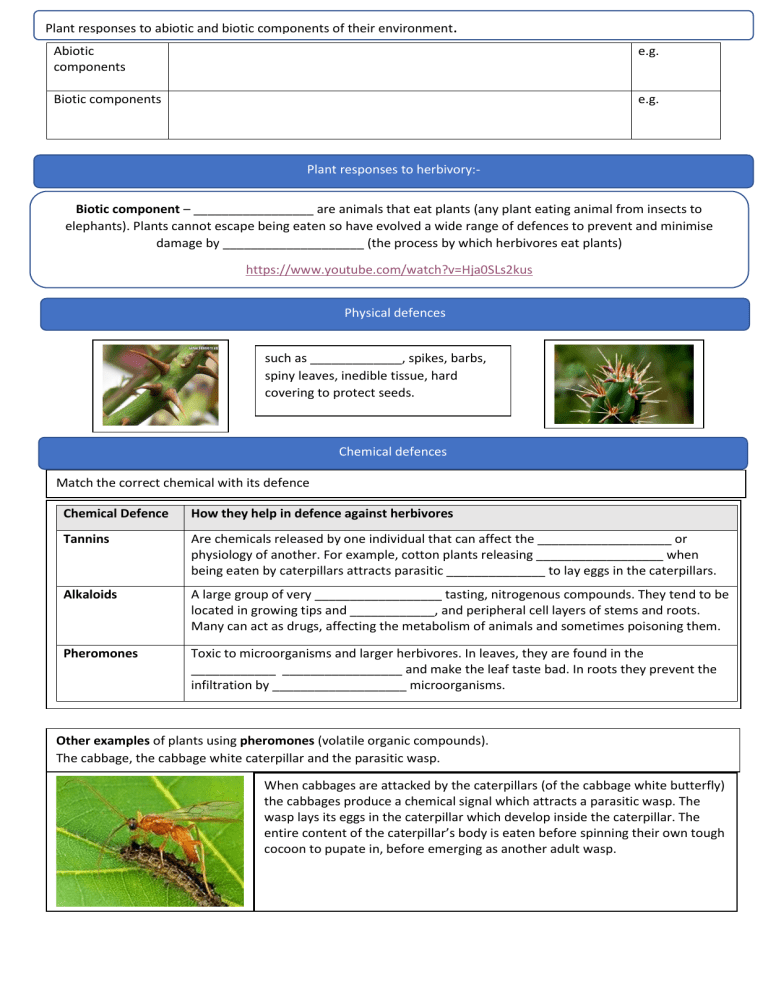
Plant responses to abiotic and biotic components of their environment. Abiotic components e.g. Biotic components e.g. Plant responses to herbivory:Biotic component – _________________ are animals that eat plants (any plant eating animal from insects to elephants). Plants cannot escape being eaten so have evolved a wide range of defences to prevent and minimise damage by ____________________ (the process by which herbivores eat plants) https://www.youtube.com/watch?v=Hja0SLs2kus Physical defences such as _____________, spikes, barbs, spiny leaves, inedible tissue, hard covering to protect seeds. Chemical defences Match the correct chemical with its defence Chemical Defence How they help in defence against herbivores Tannins Are chemicals released by one individual that can affect the ___________________ or physiology of another. For example, cotton plants releasing __________________ when being eaten by caterpillars attracts parasitic ______________ to lay eggs in the caterpillars. Alkaloids A large group of very __________________ tasting, nitrogenous compounds. They tend to be located in growing tips and ____________, and peripheral cell layers of stems and roots. Many can act as drugs, affecting the metabolism of animals and sometimes poisoning them. Pheromones Toxic to microorganisms and larger herbivores. In leaves, they are found in the ____________ _________________ and make the leaf taste bad. In roots they prevent the infiltration by ___________________ microorganisms. Other examples of plants using pheromones (volatile organic compounds). The cabbage, the cabbage white caterpillar and the parasitic wasp. When cabbages are attacked by the caterpillars (of the cabbage white butterfly) the cabbages produce a chemical signal which attracts a parasitic wasp. The wasp lays its eggs in the caterpillar which develop inside the caterpillar. The entire content of the caterpillar’s body is eaten before spinning their own tough cocoon to pupate in, before emerging as another adult wasp. Folding in response to touch Most plants move so slowly you cannot follow the movement with the naked eye. There are some exceptions:https://www.youtube.com/watch? v=nPf3FbR6eQE Mimosa pudica Sundew plant https://www.youtube.com/watch?v= b86SG9Y8Hk4 Venus fly trap https://www.youtube.com/watch?v =O7eQKSf0LmY How does the Mimosa pudica curl up when touched? Current research suggests the following:- Scientists believe that when the leaf is touched it results in something similar to an ___________ potential which causes the _____________ transport of potassium ions into the cells on the flexor side of the pulvinus. In the diagram above the cells on the flexor side are in the bottom part of each pulvinus. The active transport of potassium into the cells on the flexor side create a water potential _____________ so water will move into the cells (follow the potassium ions) on the flexor side of the pulvinus by _______________. The _______________ pressure in these cells increases and as a result the leaflet or whole leaf bends. When the plant recovers, the situation is reversed – potassium ions return to their resting levels and water leaves the flexor cells by osmosis. This movement of the plant may scare the herbivore or make the plant look less appealing to eat. active osmosis gradient turgor action You don’t have to remember these facts. This has potential for an application question. Plant Growth responses Tropism – is a directional _______________ response in which the direction of the response is determined by the direction of the external _____________________. Plants must be able to grow and respond to variations in environmental conditions. Match the correct tropism to its description Do not confuse tropic with trophic Type of tropism Description phototropism Shoots of climbing plants such as ivy, wind around other plants or solid structures to gain support Shoots grow towards light (they are positively phototropic), which enables them to photosynthesise Roots grow towards the pull of gravity (positively geotropic). This helps to anchor the plant in the soil enabling them to take up water, which is needed for support (to keep cells ___________), as a raw material for ________________ and to help cool the plant. There will also be minerals, such as nitrate in the water, needed for the synthesis of ___________ ___________. Shoots will grow away from the pull of gravity, shoots are negatively __________________. geotropism chemotropism thigmotropism On a flower, pollen tubes grow down the style, attracted by chemicals, towards the ovary where ________________________ can take place. Plant hormones coordinate the plant responses to environmental stimuli. They are chemical ________________ that can be transported away form their site of manufacture to act on target cells binding to specific _______________ on the cell surface membrane by ________________fit. Plant hormones are produced in a variety of tissues in the plant and can have different affects on different tissues. Plant hormones can influence cell ___________, cell elongation or cell ________________________. Hormones move around the plant in any of the following ways:- active ______________, diffusion and ___________ _____________ in the phloem or in ________________ vessels. mass flow complementary transport receptors messengers division differentiation Complete the table below on the different types of hormones and their effects Hormone Cytokinins (not to be confused with cytokines) Effects Promotes fruit ripening Promotes seed germination and growth of stems Auxins e.g. ________________ Inhibits seed germination and growth. Causes stomatal closure when the plant is stressed by low water availability. Plant cell walls limit cells’ ability to divide and expand. Growth only happens in particular tissues in the plant where there are groups of immature cells that are still capable of dividing, called _______________. The diagram shows the different meristems in plants. Use your book to help you complete the table below Type of meristem Apical meristem Description Lateral bud meristem Lateral meristems Intercalary meristems How Auxins work - Remember this from GCSE? Rules to remember! Auxin stimulates elongation of cells in a shoot but inhibits cell elongation in the cells in a root Auxins – A Level Use your class book or doddle to write down the mechanism of auxin’s effect. Auxins are produced at the _____________ of the shoot. The auxin moves to the cells in the zone of ___________________, causing them to elongate, and making the shoot _________________. When light is equal on all sides, the auxin simply promotes shoot growth ___________________. evenly elongation apex grow Use your knowledge on auxins to explain the results of these famous experiments. Geotropism The clinostat continually rotates the germinated seeds. The diagram shows the roots of the germinated seeds. The germinated seeds on the right of the diagram are not rotated at all. Can you explain the results seen in the diagram to the left? Auxins and cell elongation Auxins that are synthesised in the __________________ cells. Auxins ________________ away from the tip and bind to _________________ sites. Vacuoles form and H+ are actively transported by ATP_______ enzyme on the plasma membrane into the cell _____________. This lowers the ________ creating optimum conditions for wall loosening enzymes to work. The _______________ in the cell walls is broken down, the wall becomes less ________________ and can expand as the cell takes in more water and the vacuoles fill. If light is evenly distributed over the shoot then it will grow straight up. Auxins and apical dominance The apical bud secretes ____________, which _____________ growth in lower side stems by inhibiting the lateral buds from growing. If the tip is removed then the plant starts to grow side branches form ______________ buds. inhibits auxins lateral Pruning removes the apical meristem which means the lateral buds can now grow. Gibberellins In Japan, a fungus causes a disease which makes rice plants grow very tall. The fungal compounds involved are gibberellins and include gibberellic acid (GA3). Scientists have also applied gibberellic acid to dwarf varieties of plants and they grew taller. This suggests gibberellic acid causes stem elongation. Further investigations have shown that gibberellins cause growth in the internodes by stimulating cell____________ and cell ____________________. elongation division Gibberellins and seed germination In seed germination, what secretes gibberellins? What triggers their production? What is the source of ATP? What is the ATP needed for? What do gibberellins do? What does ABA do? What is the experimental evidence that gibberellins are needed for germination of seeds? Leaf Abscission Leaf Abscission – is caused by reduced levels of _________________ and increased levels of _________________. The part of the leaf stem that breaks when the leaf is shed is called the __________ ___________. Normally __________ inhibits leaf abscission by acting in this __________. The abscission zone is made up of an _____________ layer and a _______________ layer. When leaves age (leaf senescence) ______________ production at the ____________tip is reduced. This causes an increase in ____________ production and makes the cells in the ____________ zone more sensitive to ______________. Ethene increases the production of __________________ which digests cell _________ in the abscission zone by causing the leaf to fall. Stomatal closure Abscissic acid (ABA) is a key hormone that regulates water status and stomatal movement. Under drought conditions, plants produce and accumulate increased concentrations of ABA in the guard cells, and this induces stomatal closure to conserve water. Summary of some of the hormones and their functions
